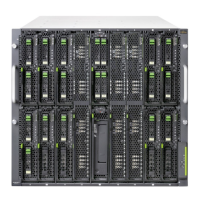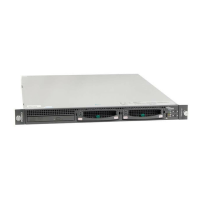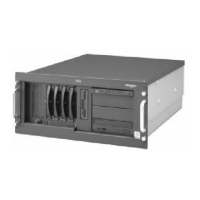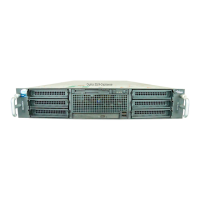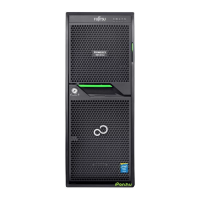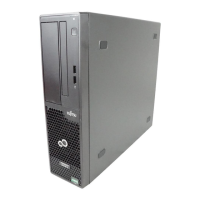Do you have a question about the Fujitsu PRIMERGY BX920 S2 and is the answer not in the manual?
Provides essential safety information for using the product correctly.
Details the product's compliance with radio interference regulations.
Information on the limited life of electrolytic capacitors and their implications.
Defines intended uses and limitations regarding high safety applications.
Recommendations for preventing issues caused by momentary voltage drops.
Information on export restrictions for technology controlled by Japanese law.
Confirms product conformance to harmonic current standards.
Details specific information for SATA hard disk drives for the Japanese market.
Defines the manual's purpose, scope, and intended audience.
Lists related documentation and where to find them.
Explains the CSS concept for component identification and replacement.
Describes features of the system board and technical manual.
Details the optional TPM for secure key storage and its activation.
Information on supported mezzanine cards for expanding server capabilities.
Overview of the server blade's SAS HDD capabilities and hot-plug support.
Details the onboard SAS controller for managing hard disk drives.
Information about the integrated graphics controller and monitor connection.
Describes the available external connectors on the server blade.
Explains features like ECC for data integrity and availability.
Details the iRMC S2 controller for remote management and its features.
Overview of server management using ServerView software and PDA technology.
Information on using ServerView Installation Manager for server configuration.
Provides power consumption and thermal dissipation details.
Lists standards for safety, EMC, and environmental conditions.
Details product safety certifications for various regions.
Provides physical dimensions and weight of the server blade.
Specifies the maximum weight of the server blade.
Defines operating and transport temperature and humidity ranges.
Guidance on reading important notes and safety instructions before proceeding.
Steps for unpacking and preparing the server blade for installation.
Instructions for physically installing the server blade into the system unit.
Familiarization with the server blade's control panel and indicators.
Methods and procedures for installing the operating system on the server blade.
Provides critical safety warnings and guidelines for handling the server.
Safety precautions to observe before powering on the server.
Safety measures during server installation and operation.
Specific safety instructions for handling and replacing batteries.
Guidelines for safe operation and handling of optical drives and media.
Warning regarding laser class 1 compliance and potential hazards.
Safety procedures for handling components sensitive to electrostatic discharge.
Confirms the system's compliance with relevant EC directives.
Warning about potential radio interference in domestic environments.
Guidelines for safely transporting the server blade.
Specific precautions for installing the server blade into the system unit.
Information on environmentally friendly design, energy saving, and disposal.
Step-by-step instructions for unpacking the server blade.
Detailed procedure for inserting the server blade into the system unit.
Instructions for removing and installing dummy modules for cooling and EMC.
Details on connecting external devices and cables to the server blade.
Procedures for safely connecting and disconnecting cables.
Identifies and explains all control buttons and status indicators on the server.
Procedures for powering the server blade on, off, and its behavior after power failure.
Guides on configuring the server blade and installing the operating system.
Instructions for safely cleaning the exterior of the server blade.
Steps to enter and access the BIOS Setup utility.
Explanation of how to navigate and interact with the BIOS setup screens.
Details on the SysInfo menu for viewing system information.
Configuration options for system time, date, and boot features.
Advanced system, memory, and processor configuration settings.
Options for setting passwords and protecting system security.
Settings related to power-on sources and power failure recovery.
Configuration options for server behavior, status, and IPMI.
Defines the order of boot devices and boot priority.
Options for saving, discarding, or loading BIOS settings.
Details on activating BIOS security features to protect data and system access.
Troubleshooting steps when the server unexpectedly powers down.
Solutions for issues where the monitor display is blank.
Troubleshooting steps for monitor display issues like flickering stripes.
Resolving issues with no screen display or horizontal/vertical drift.
Steps to correct incorrect system date and time settings.
Troubleshooting steps when the system fails to boot.
Guidance on interpreting and resolving HDD error messages during boot.
Steps to address issues where a newly added drive is reported as defective.
Information on understanding and resolving general error messages.
Instructions for handling and replacing hot-plug hard disk drives.
Precautions and guidelines for handling sensitive HDD modules.
Procedure for removing and installing dummy modules in the system unit.
Detailed steps for installing and removing HDD modules.
Provides essential safety information for using the product correctly.
Details the product's compliance with radio interference regulations.
Information on the limited life of electrolytic capacitors and their implications.
Defines intended uses and limitations regarding high safety applications.
Recommendations for preventing issues caused by momentary voltage drops.
Information on export restrictions for technology controlled by Japanese law.
Confirms product conformance to harmonic current standards.
Details specific information for SATA hard disk drives for the Japanese market.
Defines the manual's purpose, scope, and intended audience.
Lists related documentation and where to find them.
Explains the CSS concept for component identification and replacement.
Describes features of the system board and technical manual.
Details the optional TPM for secure key storage and its activation.
Information on supported mezzanine cards for expanding server capabilities.
Overview of the server blade's SAS HDD capabilities and hot-plug support.
Details the onboard SAS controller for managing hard disk drives.
Information about the integrated graphics controller and monitor connection.
Describes the available external connectors on the server blade.
Explains features like ECC for data integrity and availability.
Details the iRMC S2 controller for remote management and its features.
Overview of server management using ServerView software and PDA technology.
Information on using ServerView Installation Manager for server configuration.
Provides power consumption and thermal dissipation details.
Lists standards for safety, EMC, and environmental conditions.
Details product safety certifications for various regions.
Provides physical dimensions and weight of the server blade.
Specifies the maximum weight of the server blade.
Defines operating and transport temperature and humidity ranges.
Guidance on reading important notes and safety instructions before proceeding.
Steps for unpacking and preparing the server blade for installation.
Instructions for physically installing the server blade into the system unit.
Familiarization with the server blade's control panel and indicators.
Methods and procedures for installing the operating system on the server blade.
Provides critical safety warnings and guidelines for handling the server.
Safety precautions to observe before powering on the server.
Safety measures during server installation and operation.
Specific safety instructions for handling and replacing batteries.
Guidelines for safe operation and handling of optical drives and media.
Warning regarding laser class 1 compliance and potential hazards.
Safety procedures for handling components sensitive to electrostatic discharge.
Confirms the system's compliance with relevant EC directives.
Warning about potential radio interference in domestic environments.
Guidelines for safely transporting the server blade.
Specific precautions for installing the server blade into the system unit.
Information on environmentally friendly design, energy saving, and disposal.
Step-by-step instructions for unpacking the server blade.
Detailed procedure for inserting the server blade into the system unit.
Instructions for removing and installing dummy modules for cooling and EMC.
Details on connecting external devices and cables to the server blade.
Procedures for safely connecting and disconnecting cables.
Identifies and explains all control buttons and status indicators on the server.
Procedures for powering the server blade on, off, and its behavior after power failure.
Guides on configuring the server blade and installing the operating system.
Instructions for safely cleaning the exterior of the server blade.
Steps to enter and access the BIOS Setup utility.
Explanation of how to navigate and interact with the BIOS setup screens.
Details on the SysInfo menu for viewing system information.
Configuration options for system time, date, and boot features.
Advanced system, memory, and processor configuration settings.
Options for setting passwords and protecting system security.
Settings related to power-on sources and power failure recovery.
Configuration options for server behavior, status, and IPMI.
Defines the order of boot devices and boot priority.
Options for saving, discarding, or loading BIOS settings.
Details on activating BIOS security features to protect data and system access.
Troubleshooting steps when the server unexpectedly powers down.
Solutions for issues where the monitor display is blank.
Troubleshooting steps for monitor display issues like flickering stripes.
Resolving issues with no screen display or horizontal/vertical drift.
Steps to correct incorrect system date and time settings.
Troubleshooting steps when the system fails to boot.
Guidance on interpreting and resolving HDD error messages during boot.
Steps to address issues where a newly added drive is reported as defective.
Information on understanding and resolving general error messages.
Instructions for handling and replacing hot-plug hard disk drives.
Precautions and guidelines for handling sensitive HDD modules.
Procedure for removing and installing dummy modules in the system unit.
Detailed steps for installing and removing HDD modules.
| Form Factor | Blade |
|---|---|
| Number of Processors | Up to 2 |
| Processor | Intel Xeon E5600 series |
| Memory | Up to 96 GB DDR3 |
| Storage | Up to 2 x 2.5" SAS/SATA drives |
| RAID Support | RAID 0, 1 |
| Network | Up to 4 x 1 Gbit/s or 10 Gbit/s Ethernet |
| Chassis | PRIMERGY BX900 S2 |
| Operating System Support | Windows Server, Linux, VMware |
